The following are my notes from: Technician Class 2018-2022: Pass Your Amateur Radio Technician Class Test - The Easy Way (Easywayhambooks)
Other resources I am using include: ARRL License Manual and HAM Test Online
AR Jargon:
- ARO: Amateur Radio Operator
- "Elmer" a AR mentor.
- Your AR radio license is called a "ticket."
- To "work" someone is to "make contact" with someone.
- "Silent Key" is a deceased AR, which is a throwback to the days of telegraph. Reference: VR6TC (SK) ... Tom Christian from Pitcairn Island.
- "QSL" AR use Q signals as abbreviations. A QSL card is a postcard AROs send each other as a written confirmation of their contact. Used when DXing, a hobby of receiving and identifying distant radio or television signals, or making two-contact with distant stations.
- "CW" is Morse code.
- "RTTY" is teletype.
- "Stroke", "Slash" and "Slant" denote the forward slash "/"
- "Tactical Identifiers" - Used at public events (i.e., "Race Headquarters").
- "Packet radio" is data transmission. It got the name because the data is transmitted in clumps or packets.
- "Microwave" is another way of saying UHF.
- "VFO" is Variable Frequency Oscillator
- "rubber duck" short antenna on a handheld transceiver.
- "CTCSS" is Continuous Tone-Coded Squelch System
- "DCS" Digital Code Squelch
- "DTMF" Dual-tone Multi-frequency Signal, Think of touch tone (old phones).
- "Lid" is an old telegraph expression to a poor operator. It is still used.
- "QRM": Intereference
- "QSY": Changing frequency
Book Bold Font:
How I got Started:
- Radio was are electromagnetic.
- The ionosphere is the part of the atmosphere that enables propagation around the world.
- An electrical wiring diagram that uses standard component symbols is called a schematic. Hint: A wiring diagram is a schematic.
- When sodering use rosin-core solder. Cold solder joins look grainy and dull which make a poor connection.
- Carbon-zinc batteries are non-rechargeable.
- Types of rechargeable batteries are:
- Nickel-metal hydride
- Lithium-ion
- Lead-acid gel-cell
- If you charge or discharge lead-acid batteries too quickly, they can overheat, give off flammable gas, or explode.
- Voltage is electromotive force. We measure it with a voltmeter hooked up in parallel with (across) the circuit.
- Ensure that the meter and leads are rated at the voltages to be measured.
- Current flowing through a body may cause a health hazard by:
- Heating tissue
- Disrupting electrical funcntions
- Causing involuntary muscle contractions
- The flow of electrons is called current. Electrical current is measured in amperes.
- Amperes (amps) measured with an ammeter. An ammeter is connected in series (in line) with a circuit.
- Copper is a good conductor.
- A good insulator is glass.
- Resistance is measured in ohms. The instrument to measure resistance is an ohmmeter.
- The component that is used top protect other circuit components from current overloads is a fuse.
- Don't put a 20 amp fuse in place of a 5 amp fuse or excessive current could cause a fire.
- Transceivers: Units combining the functions of transmitter and receiver.
- In the U.S., the FCC, Federal Communications Commission regulates and enforces the rules for amateur radio operators.
- Worldwide, the ITU, International Telecommunications Union regulates radio. ITU is a United Nations agency for information and communication technology issues.
- Each country's call sign is assigned prefixes to tell the person's location.
- A valid US technician class amateur radio call sign would be K1XXX. Note: technicians can request a 1x3 call sign via the vanity licensing program, but you must first receive your call, then request a change.
- You use the call sign to identify yourself, in English, at least every 10 minutes and at the end of your conversation.
- The code we use when sending CW is called International Morse code.
- FCC rules encourage the use of phonetic alphabet for station identification. To ensure voice messages containing unusual words are received correctly, spell the words using a standard phonetic alphabet.
- Any licensed amateur can apply for a different call sign.
- One person can only hold one primary station license grant.
- Your proof of possession is that your license appears in the FCC ULS consolidated database.
- Amateur radio clubs must have at least four members. You need four to form.
Introduction to Amateur Radio:
- The purpose of the Amateur Radio Service is advancing skills in the technical and communication phases of the radio art. Radio art, that's weird right?
- Worldwide, regulation is through the International Telecommunications Union (ITU) which is a United Nations agency for information and communication technology issues. [ITU=worldwide=United Nations]
- An FCC license amateur station can operate in international waters on a vessel documented or registered in the United States.
- Technician Class authorizes you to transmit on VHF (Very High Frequency 30-300MHz) and UHF (Ultra High Frequency 300-3000Mhz).
- HF High Frequency 3-30Mhz) aka short-wave. Technicians has limited privileges in short-wave.
- Frequency Dividing Lines are:
- 3-30 HF
- 30-300 VHF
- 300-3000 UHF
Who are you?
- When using tactical identifiers, your station must transmit the FCC-assigned call sign every 10 minutes during and at the end of a conversation. [Every ten minutes]
- When making on-the-air test transmissions, identify the transmitting station.
- You're required to identify with your call sign in English every ten minutes during and at the end of your contact.
- You can transmit encoded messages when transmitting control commands to space stations or radio control craft.
- You can transmit without on-the-air identification when transmitting signals to control model craft.
- The FCC defines a "space station" as an amateur station more than 50km above the earth's surface. [more than 50km]
- Call sign identification for a station transmitting phone signals can be CW or phone emissions.
- Use of the phonetic alphabet is encouraged by the FCC when identifying your station when using phone. [FCC encourages phonetics, nothing more]
Where can you operate?
- Your US amateur radio license entitles you to operate from any vessel or craft located in international waters and documented or registered in the United States. [international waters]
- You are also authorized to operate your amateur station in a foreign country when the foreign country authorizes it.
What do we Talk about?
- AR operators talk about topics incidental to purposes of the Amateur Radio Service or remarks of a personal nature.
- There is an exception for the incidental sale or trade of equipment normally used in an Amateur Radio station and not on a regular basis.
- You can charge for operating a station, BUT an exception exists for classroom instruction at an educational institution.
- Transmission that contain obscene or indecent words or language are prohibited, but there's no list of banned words.
- An amateur station is authorized to transmit music only when incidental to manned spacecraft communications.
- Broadcasting means transmissions intended ofr the reception by the general public. AR should not engage in it.
- Broadcasting, program production or news gathering is authorized where such communications relate to the immediate safety of human life or the protection of property.
- The FCC defines a beacon as an amateur station transmitting for the purpose of observing propagation or related experimental activities.
- Amateur radio stations may make one-way transmissions when transmitting code practice, information bulletins, or to provide emergency communications.
- Willful interference to other amateur radio stations is permitted at no time.
Who can talk to you?
- FCC licensed amateur radio stations are prohibited from exchanging communications with any country whose administration has notified the ITU that it objects to such communication. [North Korea If a country objects you can't talk to a AR there]
- Third party communication is a message from one control operator on the behalf of another person.
- A non-licensed person is allowed to speak to a foriegn station if the foreign station has a third-party agreement with the US. [Unless a country allows it, you can't do it]
Who is in control?
- An Amateur station is never permitted to transmit without a control operator.
- The class of operator license held by the control operator determines the transmitting privileges of an amateur station.
- A Technician Class licensee may never be the control operator of the station operating an exclusive Extra Class operator segment of the amateur bands.
- The station licensee is the one to designate the station control operator.
- The FCC presumes the station licensee to be the control operator of an amateur station unless documentation to the contrary is in the station records.
- When the control operator is not the station licensee, the control operator and the station licensee are equally responsible.
- The amateur station control point is the location at which the control operator function is performed. There are three different kinds of control: local, remote and automatic.
- The following are true of remote control (i.e., Operating a station over the internet): [Hint: the first two are always required, and the third describes remote operation]
- The control operator must be at the control point
- A control operator is required at all times
- The control operator indirectly manipulates the controls
- All of these choices are correct
- Repeater operation is an example of automatic control.
- A station that simultaneously retransmits the signal of another on a different channel or frequency is a repeater.
- What kind of stations can automatically retransmit? Repeater, auxiliary and space stations.
- If someone uses a repeater and violates FCC rules, the control operator of the originating station is accountable.
Bands and Frequencies
- The Abbreviation, RF, refers to radio frequency.
- A radio wave is made up of electromagnetic energy.
- A radio wave has two components: an electric and a magnetic field.
- A radio wave travels through free space at the speed of light. The approximate velocity is 300,000,000 meters per second.
- Direct current is the name for current that only flows in one direction. Alternating current is the name for current that reverses direction on a regular basis.
- Frequency is the term describing the number of times per second that an alternating current makes a complete cycle.
- The unit of frequency is hertz (Hz).
- The proper abbreviation for megahertz is MHZ.
- The electromagnetic spectrum is commonly broken down into three groups.
- 3 to 30 MHz HF (High Frequency)
- 30 to 300 MHz VHF (Very High Frequency)
- 300 to 3000 MHz UHF (Ultra High Frequency)
- Wavelength is the name for the distance a radio wave travels during one complete cycle.
- The wavelength gets shorter as the frequency increases.
- The formula for converting frequency to wavelength in meters is "wavelength in meters equals 300 divided by the frequency in megahertz. [the only correct answer has "300 divided by"]
- The property of radio waves often used to identify the different frequency bands is the approximate wavelength.
- 146.52MHz is in the 2 meter band
- The frequency 52.525 MHz is within the 6 meter amateur band. [52.525 MHz is a repeating number and stands out from the other answers]
Modes
- Modulation describes combining speech with an RF carrier.
- The following are digital communication modes:
- IEEE 802.11
- Packet
- JT65
- NTSC is fast-scan color TV. [C for color]
- The typical bandwidth of analog fast-scan TV transmissions is about 6 MHz. [Remember TV6]
FM Mode - Frequency Modulation
- If you are told you are over-deviating, talk further away from the microphone.
- FM is most commonly used for VHF and UHF voice repeaters.
- The approximate bandwidth of a VHF repeater FM phone signal is between 10 and 15 kHz.
- Frequency modulation (FM) is most commonly used for VHF packet radio transmission.
AM Mode - Amplitude Modulation
Single Sideband Mode (SSB)
- Single sideband (SSB) is a form of amplitude modulation.
- The voice mode used for long distance weak signal contacts on VHF and UHF is SSB.
- Upper sideband (USB) is normally used for 10 meter HF, VHF and UHF single sideband communications.
- The approximate bandwidth of a single sideband (SSB) voice single is 3kHz.
- The advantage of single sideband over FM for voice transmission is SSB signals have a narrower bandwidth.
- The ability to discriminate between multiple signals is called selectivity.
- You would use a filter 2400 Hz wide for minimizing noise and interference on SSB.
- SSB voice modulation is most often used for long distance or weak signal contacts on the VHF and UHF bands.
- If the voice pitch seems too high or too low, you would use the receiver RIT (Receiver Incremental Tuning) or Clarifier control to fine tune.
CW (Continuous Wave or Carrier Wave) Mode (Morse Code)
- International Morse code is used when sending CW in the amateur bands.
- You are not allowed to use codes or ciphers that hide the meaning of a message except when transmitting control commands to space stations or radio remote control craft.
- CW emission has the narrowest bandwidth. The approximate maximum bandwidth required to transmit CW signal is 150Hz.
- The typical filter used for CW is 500 Hz wide.
- An electronic keyer assists in the sending of Morse code.
- The advantage of having multiple bandwidth choices is it permits noise or interference reduction by selecting a bandwidth matching the mode.
Bandplans
- As a Technician class operator, you have HF phone privileges on 10 meters only. A Technician class operator has, HF, RTTY, and data privileges on 10 meters only. [The answer to both question about HF is 10 meters]
- In the HF bands, a Technician is limit to 200 watts output power. Above 30MHz, a Technician can use up to 1500 watts.
- The VHF frequencies limited to CW only are 50MHz to 50.1MHz and 144.00MHz to 144.1MHz.
- Between 219 and 220 MHz, is limited to fixed digital messaging forwarding systems only.
- When the Amateur Radio Service is secondary, you may find non-amateur stations and must avoid interfering.
- You should not set your transmit frequency to be exactly at the edge of an amateur band:
- To allow for a calibration error in the transmitter display frequency.
- So that modulation sidebands do not extend beyond the band edge.
- To allow for transmitter frequency drift.
- SSB phone may be used in at least some portion of amateur bands above 50MHz.
- There are also voluntary guidelines beyond the privileges established by the FCC.
- The national calling frequency on the 2 meter band is 146.520 MHz. That is the watering hole where everyone goes to look for a contact.
- BTW - there are national calling frequencies on other bands but you don't need to know them for the test.
Propagation
- If the the other station reports your signal was strong a moment ago but is now weak or distorted, try moving a few feet or change the direction of your antenna as reflections may be causing multi-path distortion.
- The term, picket fencing, is commonly used to describe the rapid fluttering sound sometimes heard from mobile stations that are moving when transmitting.
- The part of the atmosphere called the ionosphere enables the propagation of radio signals around the world.
- The peak of the sunspot cycle makes long-distance communication possible on six or ten meters. [the other answers are all UHF bands which do not refract off the ionosphere]
- The advantage of HF vs VHF and higher frequencies is long distance ionosphere propagation is more common on HF.
- Direct UHF signals (not on a repeater) are rarely heard from stations outside your local coverage area because UHF signals are usually not reflected by the ionosphere.
- VHF and UHF radio signals usually travel somewhat farther than the visual line of sight distance between two stations because the Earth seems less curved to radio signals than to light.
- This is because air bends the radio wave over the horizon causing the phenomenon.
- The range of VHF and UHF signals might be greater in the winter because there is less absorption by vegetation.
- Fog and light rain have little effect on 10 and 6 meters.
- HF is not much affected by weather.
- At microwave frequencies, precipitation can decrease range.
- Knife-edge diffraction might cause signals to be heard despite obstructions between the transmitting and receiving stations.
- Tropospheric ducting is caused by temperature inversions in the atmosphere.
- The phenomenon responsible for allowing over the horizon VHF and UHF communications to ranges of approximately 300 miles on a regular basis is tropospheric scatter.
- Signals exhibiting rapid fluctuations of strength and often sounding distorted is a characteristic of signals received via auroral reflection.
- The band best suited to communicating via meteor scatter is 6 meters. [meteor has 6 letters, so 6 meters]
- Occasional strong over-the-horizon signals on the 10, 6, and 2 meter bands are sporadic E
- The ionosphere is divided into several layers (D, E and F), The E layer has a component that can be unpredictable and sporadic.
Be Safe, Stay Safe
- A fuse protects circuits from current overloads.
- The purpose of a fuse is to interrupt power in case of an overload.
- Equipment powered from 120v AC power circuit should always include a fuse or circuit breaker on the hot conductor.
- Don't put a 20-ampere fuse in place of a 5-ampere fuse or excessive current could cause a fire.
- To guard against electrical shock:
- User three-wire cords.
- Connect to a common safety ground.
- Use ground fault interrupters.
- The green wire on a plug goes to safety ground.
- When putting up a tower, look and stay clear of overhead wires.
- To determine the minimum safe distance from a power line, make sure if the antenna falls, it can come no closer than a minimum of 10 feet.
- Don't attach an antenna to a utility pole because the antenna could contact the high-voltage power lines.
- Use carefully inspected climbing harness and safety glasses when climbing a tower.
- Wear a hard hat and safety glasses at all times when any work is being done on the the tower.
- It is never safe to climb a tower without a helper or observer.
- Never climb a crank-up tower unless it is retracted or mechanical locking devices have been installed.
- A gin pole is an extensions that is used to lift tower sections or antennas above the top of the tower.
- A safety wire through a turnbuckle is to prevent loosening of the guy line.
- Local electrical codes set grounding requirements.
- The lowest impedance (resistance) to RF signals is flat strap.
- Proper grounding for a tower is a separate eight-foot rod for each leg bonded to the tower and each other.
- When installing ground wires on a tower for lighting protection, ensure that all connections are short and direct. For lighting protect, short bends must be avoided.
- Mount all devices for lighting protection to a metal plate that is in turn connected to an external ground rod.
- You should bond all external ground rods or earth connections with heavy wire or conductive strap.
- VHF and UHF are non-ionizing radiation. RF radiation differs from ionizing radiation (radioactivity) because RF doe snot have sufficient energy to cause genetic damage.
- The factors affecting RF exposure are:
- Frequency and power level.
- Distance from the antenna.
- Radiation pattern of the antenna.
- Exposure limits v ary with frequency because the human body absorbs more RF at some frequencies than others.
- 50MHz has the lowest value for Maximum Permissible Exposure Limit. [This means this 6 meter band heats our body the most]
- If you run more than 50 watts at the antenna on VHF frequencies, you are supposed to do an RF exposure evaluation.
- To stay in compliance, you should re-evaluate whenever you change equipment.
- An acceptable way to check exposure is using:
- FCC Bulletin
- Computer modeling.
- Measurement of field strength using calibrated equipment.
- To prevent exposure, try relocating the antennas. The further away the better.
- Duty cycle is the percentage of time the transmitter is transmitting. Duty cycle is a factor because it affects the average exposure.
- If the limit is 6 minutes and you are on 3 and off 3, you can be exposed safely for two times as long.
- A person touching your antenna might get a painful RF burn.
Radio Operation
- Transceivers which combine a transmitter and receiver.
- If you are transmitting and receiving on the same frequency, it is simplex communication.
- Modern radios will let you store the frequency in memory channels for quick access.
- You can also enter your frequency by typing it on a keypad or use the VFO knob.
- The scanning function of an FM transceiver is used to scan through a range of frequencies to check for activity.
- An oscillator is a circuit that generates a signal at a specific frequency.
- A disadvantage of the "ribber duck" antenna supplied with most handheld transceivers is it does not transmit or receive as effectively as a full-sized antenna.
- A good reason not to use a handheld transceiver inside your car is that signals may not propagate as well due to the shielding effect of the vehicle.
- The device that increases the low power output from a handheld is an RF power amplifier.
- The function of the SSB/CW-FM switch on an amplifier is to set the amplifier for proper operation in the selected mode.
- The squelch control mutes the receiver output noise when no signal is present.
- A sub-audible tone transmitted along with normal voice audio to open the squelch of a receiver is called CTCSS (Continuous Tone-Coded Squelch System).
- ORM means "I am receiving interference."
- QSY means " I am changing frequency."
- Contacting as many stations as possible during a specific time is contesting. In a radio contest, you send only the minimum information needed for proper identification and the contest exchange.
- A Grid Locater is a letter-number assigned to a geographic location.
How to Start a Conversation
- CQ means calling any station.
- On a repeater, in place of CQ, just say your call sign.
- To call another station on the repeater, if you know his call sign, say the other station's call sign, then identify your call sign.
- If two stations are on the same frequency and interfere, use common courtesy, but no one has an absolute right to a frequency.
- To respond to a CQ, transmit the other station's call sign followed by your call sign.
- Before choosing an operating frequency for calling CQ:
- Listen first to be sure no one is using the frequency.
- Ask if the frequency is in use.
- Make sure you are in your assigned band.
Extending Your Range with Repeaters
- Simplex communication is the term used to describe an amateur station transmitting and receiving on the same frequency.
- Simplex channels are designated in the VHF.UHF band plans so stations can communicate directly without using a repeater.
- A repeater simultaneously retransmits a signal on a different channel and channels.
- Repeater, auxiliary, and space stations can automatically retransmit.
- A linked repeater network is a network of repeaters where signals received by one are repeated by the others.
- To prevent interference, a Volunteer Frequency Coordinator recommends receive/transmit channels and other parameters.
- A Frequency Coordinator is selected by local amateur operators whose stations are eligible to be repeater or auxiliary stations. [they're selected by amateurs]
- Simplex communication is the term used to describe an an amateur station transmitting and receiving on the same frequency.
- "Repeater offset" is the difference between a repeater's transmit and receive frequencies. A common repeater offset in the 2 meter band is plus or minus 600kHz.
- A common use of the "reverse split" function of a VHF/UHF transceiver is to listen on a repeater's input frequency.
- If you can here the input, you might be able to go to simplex communication and not tie up the repeater.
- If a station is not strong enough to keep the repeater's receiver squelch open, you might be able to receive the station's signal by listening on the repeater input frequency.
- A common repeater frequency offset in the 70cm band is plus or minus 5 MHz.
- A way to enable quick access to a favorite frequency on your transceiver is to store the frequency in a memory channel.
- Continuous Tone Coded Squelch System (CTCSS) is the term used to describe the use of the sub-audible tone transmitted with normal voice audio to open the squelch of a receiver.
- If you can hear a repeater's output but can't access it, a reason might be:
- Improper transceiver offset.
- The repeater may require a CTCSS tone
- The repeater may require a DCS tone
- DMR (Digital Mobile Radio or Digital Migration Radio) describes a system for time-multiplexing two digital voice signals on a single repeater channel. [Means two people can talk on the same channel]
- A "Talk Group" on a DMR digital repeater is a way for groups of users to share a channel without being heard by other users of the channel. [you only hear users of that group]
- To join a repeater's talk group, program your radio with the group's ID or code.
- A station that is used to connect other amateur stations to the internet is called a gateway.
- The Internet Radio Linking Project (IRLP) connects amatuer radio systems via the internet.
- The tones used to control repeaters linked by the IRLP protocol are DTMF.
- You can also access some IRLP nodes by using DTMF signals
- Before you can use the Echolink system, you must register your call sign and provide proof of license.
- Voice Over Internet protocol is a method of delivering voice over the internet using digital techniques.
- You can find lists of active nodes that use VoIP by
- subscribing to an online service
- from online repeater lists maintained by the local frequency coordinator
- from a repeater directory
Operating Simplex
- The national calling frequency for FM simplex operations in the s meter band is 144.520 MHz.
- The meaning of the procedural signal "CQ" is calling any station.
- Before choosing an operating frequency for calling CQ:
- Listen first to be sure no one else is using the frequency
- Ask if the frequency is being used
- Make sure you are in the assigned band
- When responding to a CQ, you should transmit the other station's call sign followed by you call sign. For Example: "W3ABC this K4IA"
- You identify every ten minutes and at the end of your communication (conversation).
- Call sign identification for a station transmitting phone signals can be CW or phone emissions. For Example a repeater will use CW "K4TS/R" where the first part before the forward slash is the call sign and /R indicates the station as repeater.
Emergency
- To get the attention of a net control station in an emergency, begin your transmission by saying "Priority" or "Emergency" followed by your call sign.
- The term "NCS" refers to Net Control Station.
- Once you have checked into a net, remain on frequency without transmission until asked.
- You can operate outside of frequency privileges of your license class in situations involving the immediate safety of human life or protection of property
- Two groups that organize for emergency communication: RACES and ARES.
- RACES is:
- A radio service for emergency management and civil defense.
- A radio service using amateur stations for emergency management or civil defense.
- An emergency service using amateur operators certified by a civil defense.
- ARES is licensed amateurs who have voluntarily register their qualifications and equipment for communications duty.
- RACES is:
- What RACES and ARES have in common is that both may provide communications during emergencies.
- "Traffic" refers to formal messages exchanged by net stations.
- Good traffic handling is passing messages exactly as received. [word-for-word, not interpretted, condensed or editorialized]
- One way to ensure a voice message containing unusual words is copied correctly is to spell the words using standard phonetic alphabet.
- The FCC encourages the use of a standard phonetic alphabet. [but doesn't publish one]
- Use the standard phonetic alphabet adopted by International Telecommunication Union (ITU).
- The preamble contains the information needed to track the message as it passes through the system. [similar to "To" and "From"]
- "Check" is a count of the number of words in the text portion of the message.
Satellites
- A satellite beacon is a transmission from a satellite that contains status information.
- Telemetry information typically transmitted by a satellite beacon is information about the health and status of a satellite.
- Anyone who can receive telemetry signal may do so.
- The mode of transmission used for satellite beacon is:
- RTTY (teletype)
- CW (Morse code)
- Packet (short bursts of digital data)
- LEO means the satellite is in Low Earth Orbit.
- Repeaters, auxiliary and space stations are all repeaters and can automatically retransmit signals.
- You can talk to the International Space Station is you have a Technician or above License.
- Satellite tracking programs provide maps showing:
- The position of the satellite
- Time Azimuth and Elevation
- The Doppler shift
- The inputs to a satellite tracking program are the Keplerian elements.
- "Spin fading" is caused by the rotation of the satellite and antennas.
- "Doppler shift" is an observed change in frequency caused by the relative motion between the satellite and Earth station.
- UHF signals are usually not reflected by the ionosphere.
- A satellite operating in U/V mode is using an uplink of 70 centimeter band and a downlink in the 2 meter band. [70 cm = UHF and 2 m is VHF]
- The control operator of a station communicating through a satellite must have license privileges that allow him to transmit on the satellite uplink frequency.
- If you use too much power on the uplink, you can block access by other users.
- A good way to judge whether your uplink power is too low or too high is your signal strength on the downlink should be about the same as the beacon.
Computers
- A computer might be used as part of an amateur radio station:
- For logging contacts
- For sending and receiving CW
- For generating and decoding digital signals
- Digital communications modes include:
- Packet
- IEEE 802.11
- JT65
- Your computer sound card provides audio to the microphone and converts received audio to digital form.
- The connections between a voice transceiver and a computer would be: receive audio, transmit audio and push-to-talk (PTT).
- The computer sound card port connected to a transceiver's headphone or speaker output would be the microphone or line input.
- Included in a packet transmission are a:
- Header with the call sign of the station to which the information is sent.
- Check sum which permits error detection
- Sutomatic repeat request in case of error
- An ARQ transmission system detects errors and sends a request to retransmit.
- APRS means Automatic Packet Reporting System.
- An Application of APRS is to provide real-time tactical digital communications in conjunction with a map showing the locations of stations. Data to the transmitter for automatic position reports is supplied by a GPS (Global Positioning System) receiver. [APRS reads your location from GPS and broadcasts it]
- PSK, which stands for Phase Shift Keying. [this is a popular digital mode on HF] the computer's sound card can generate PSK.
- The following [weak signal] activities are supported by digital mode software in the WSJT suite:
- Moonbounce or Earth-Moon-Earth
- Weak signal propagation beacons
- Meteor scatter
- I have installed WSJT on my laptop, check it out sometime.
- FT8 is a digital mode capable of operating in low signal-to-noise conditions that transmit at 15-second intervals. [program in WSJT suite]
- Broadband Hamnet is an amateur-radio based data network using commercial Wi-Fi gear with modified firmware.
Radio Design
- The presence of a signal is determined by the receiver's sensitivity. A receiver's selectivity is the ability to discriminate between signals.
- Oscillator - the circuit that generates a signal at a specific frequency.
- Convert a signal from one frequency to another with a mixer.
- You convert the RF input and output to another band using a transverter. [If you see transverter in a n answer, it is always right]
- Power line noise or ignition noise might go away if you turn on the noise blanker. [Blank the noise with a noise blanker]
- AGC - Automatic Gain Control keeps the received audio relatively constant.
- You would put an RF preamplifier between the antenna and receiver if receiver needs help with weak signals.
- A mobile transceiver typically requires about 12 volts.
- The component commonly used to change 120V AC house current to a lower voltage is a transformer.
- The circuit that controls the amount of voltage from a power supply is a regulator.
- The device that changes an alternating current to direct current is a rectifier.
- To determine the minimum current capacity needed for a transceiver power supply, you need to consider:
- Efficiency of the transmitter at full output
- Receiver and control circuit power.
- Power supply regulation and heat dissipation.
- All of the choices are correct.
- Wiring between the power source and the radio should be heavy-gauge and kept short as possible to avoid voltage falling below that needed for proper operation.
Clean Up the Signal
- Too high a microphone gain and the output may become distorted.
- If you are told you are over-deviating, move away from the microphone.
- If you are told your transmissions are breaking up on voice peaks, you are talking to loudly.
- A high-pitched whine in a mobile transceiver that varies with speed is usually the car's alternator.
- A symptom of RF feedback is reports of garbled, distorted or unintelligible transmission.
- Shielded wire prevents coupling of unwanted signals to or from the wire. [Shield prevents coupling]
- To cure distorted audio caused by RF current on the shield of a microphone cable use a ferrite choke. [A ferrite choke chokes off the RF]
- To reduce or eliminate interference to a nearby telephone put an RF filter on the telephone. [Filter RF with a filter]
- The first step to resolve cable TV interference is to be sure all the connectors are installed properly.
- Radio frequency interference may be caused by Fundamental overload, Harmonics and/or Spurious emissions. All choices are correct.
- An AM/FM radio might receive amateur radio transmissions because the receiver is unable to reject strong signals outside the AM or FM band. {This is an example of fundamental overload, the amateur radio is too strong}
- To reduce the overload of a non-amateur radio or TV, block the amateur signal with a filter on the antenna input of the receiver.
- A band-reject filter can reduce the overload to a VHF transceiver from nearby FM broadcast station.
- If a neighbor complains you are interfering with their radio or TV, make sure your station is not causing interference to your own radio or television.
- Part 15 devices are unlicensed and may emit pow power radio signals on frequencies used by license services.
- If something in a neighbor's home is causing harmful interference to your amateur station,
- Work with your neighbor
- Check your station
- Politely inform
- All the choices are correct.
Electronic Theory
- The electrical component that opposes the flow of current in a DC circuit is called a resistor.
- Adjustable volume controls are potentiometers, variable resistors.
- Conductors are composed of a coil wire. Inductors store energy in a magnetic fields.
- The ability to store energy in a magnetic field is called inductance.
- The basic unit of inductance is the henry.
- Impedance is the measure of opposition to AC current flow. The impedance is measured in ohms.
- Two or more conductive surfaces separated by an insulator, make up a capacitor. The ability to store energy in an electrical field is called capacitance.
- The electrical component that stores energy in an electrical field is called a capacitor.
- The basic unit of capacitance is called a farad.
- An inductor is combined with a capacitor to make a tuned circuit. A resonant or tuned circuit is an inductor and capacitor connected in series or parallel to form a filter.
- If an ohmmeter indicates low resistance and then increasing resistance with time, the circuit contains a large capacitor.
- When a power supply is turned off, you might still receive a shock from stored charge in a large capacitor.
- A component made of three layers of semiconductor material is a transistor.
- Transistors are components capable of using a voltage or current to control current flow.
- A transistor can be used as a switch or an amplifier. Electronic components that can amplify signals are transistors.
- The term that describes a transistor's ability to amplify a signal is called gain. The primary gain-producing component in an amplifier is a transistor.
- An FET is a special kind of transistor called a Field Effect Transistor.
- The component that allows current to flow in only one direction is a diode.
- The device or circuit that changes an alternating current to a direct current is a rectifier.
- The two electrodes of a diode are called the anode and cathode. The anode is the positive side.
- The cathode end of a diode is often marked with a stripe.
- The abbreviation LED stands for light emitting diode. An LED is commonly used as a visual indicator.
Volts, Ohms, Amperes and Power - Ohm's Law
- Voltage represents electromotive force. The unit of electromotive force is the volt.
- A circuit where the voltage is the same across all components is in parallel. [That is why all your household electrical outlets have the same voltage]
- At the junction of two components in parallel, the current divides depending on the value of the components. [The voltage remains the same but the current divides]
- The voltage across each of two components in parallel is the same as the voltage at the source.
- Components in series (end-to-end) will have the same current through each of them. [If you connect a small hose to a large hose, the same amount of water flows but the pressure changes]
- A circuit where the current is the same through all the components is in series. At the junction of two components in series, the current remains the same.
- The voltage across each component is determined by the type and value of the components.
- Ohm's Law: Voltage = Amperes times Resistance. E=IR
- Magic circle (Eagle flies over the Indian and Rock) E/IR. Put your thumb over the value you are solving for.

- The formula used to calculate current in a circuit is voltage divided by resistance.
- The formula used to calculate voltage in a circuit is current multiplied by resistance.
- The formula used to calculate resistance in a circuit is voltage divided by current.
Power in Watts
- The rate at which electrical energy is used is called power. Electrical power is measured in Watts.
- The formula to calculate electrical power in a DC circuit is Power (P) equals Voltage (E) multiplied by Current (I). P=IE
- Power Magic Pie

How to Draw a Radio
- Schematic symbols represent electrical components.
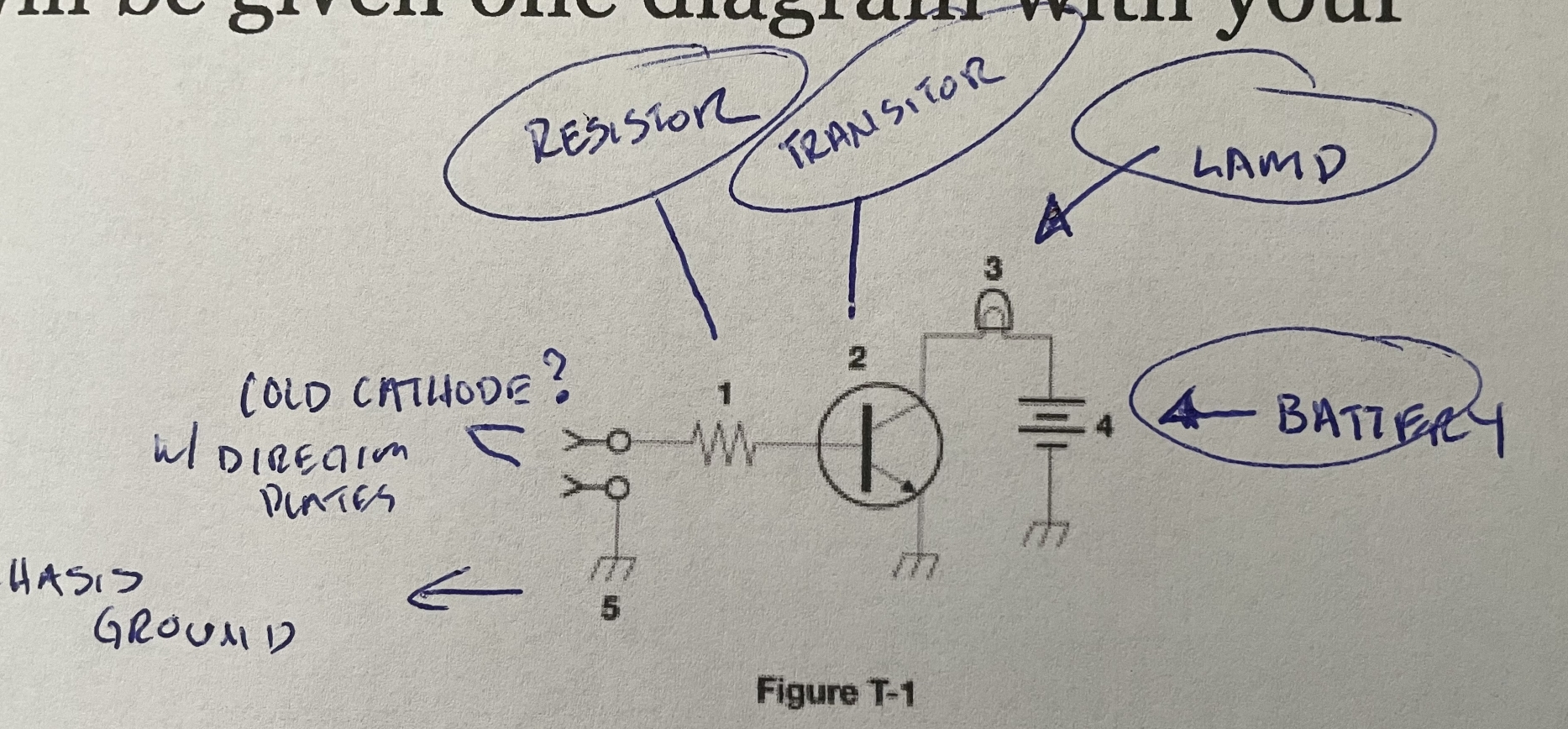
- Component 1 is a resistor.
- Component 2 is a transistor which controls current. A transistor can be an amplifier or a switch. A switch connects or disconnects circuits.
- Component 3 is a lamp.
- Component 4 is a battery. [long and short lines representing cells. If it only had two lines it would be a capacitor]
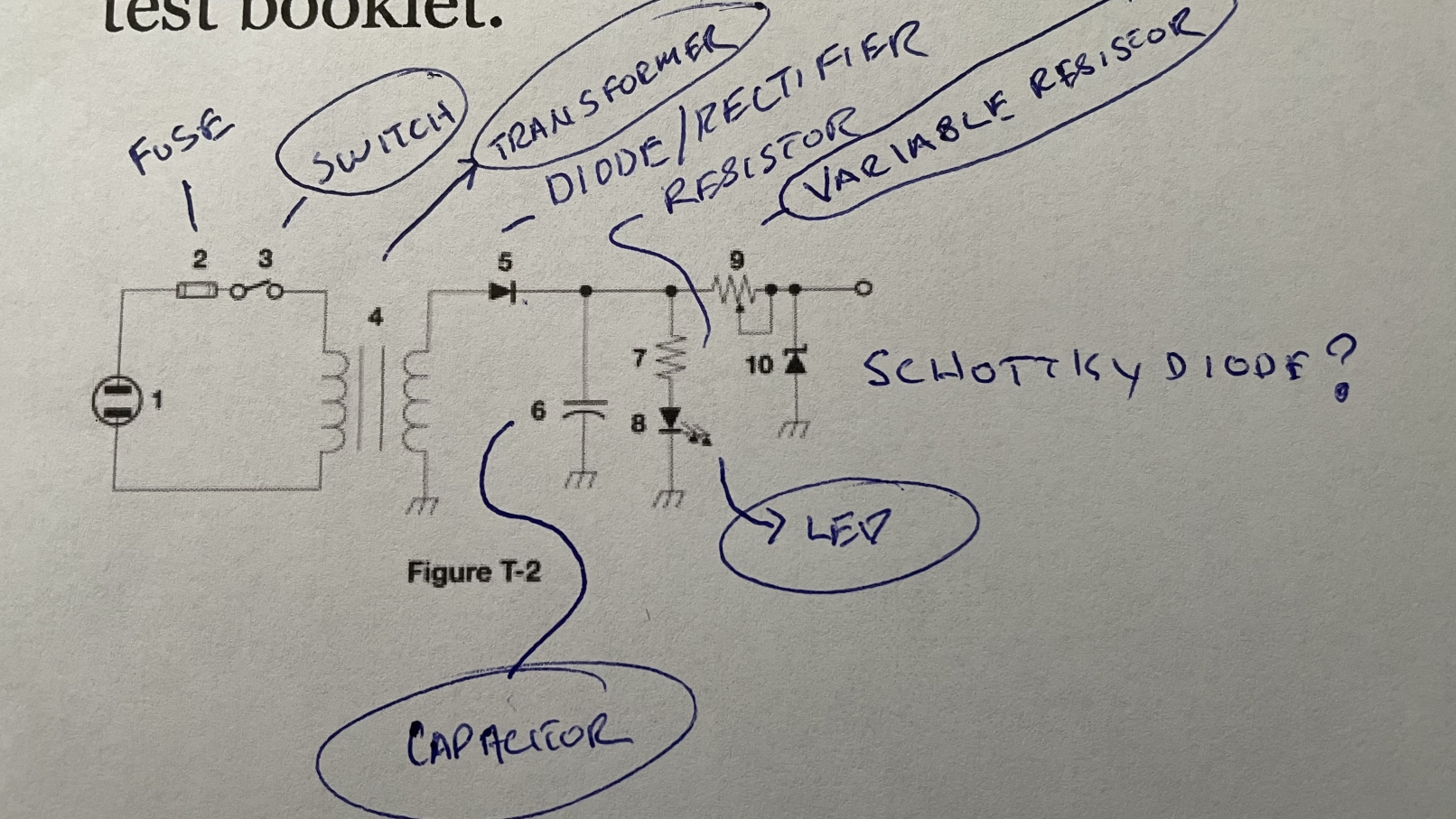
- Component 3 is switch. This switch represents a single-pole single-throw. [One wire in one wire out]
- Component 4 is a transformer.
- A transformer is used to change 120v AC house current to lower voltage for other uses.
- Component 6 is a capacitor.
- Component 8 is a light emitting diode. [The arrows are light coming out of the LED]
- A light emitting diode is commonly used as a visual indicator.
- LED means light emitting diode.
- Component 9 is a variable resistor. [arrow makes it variable]
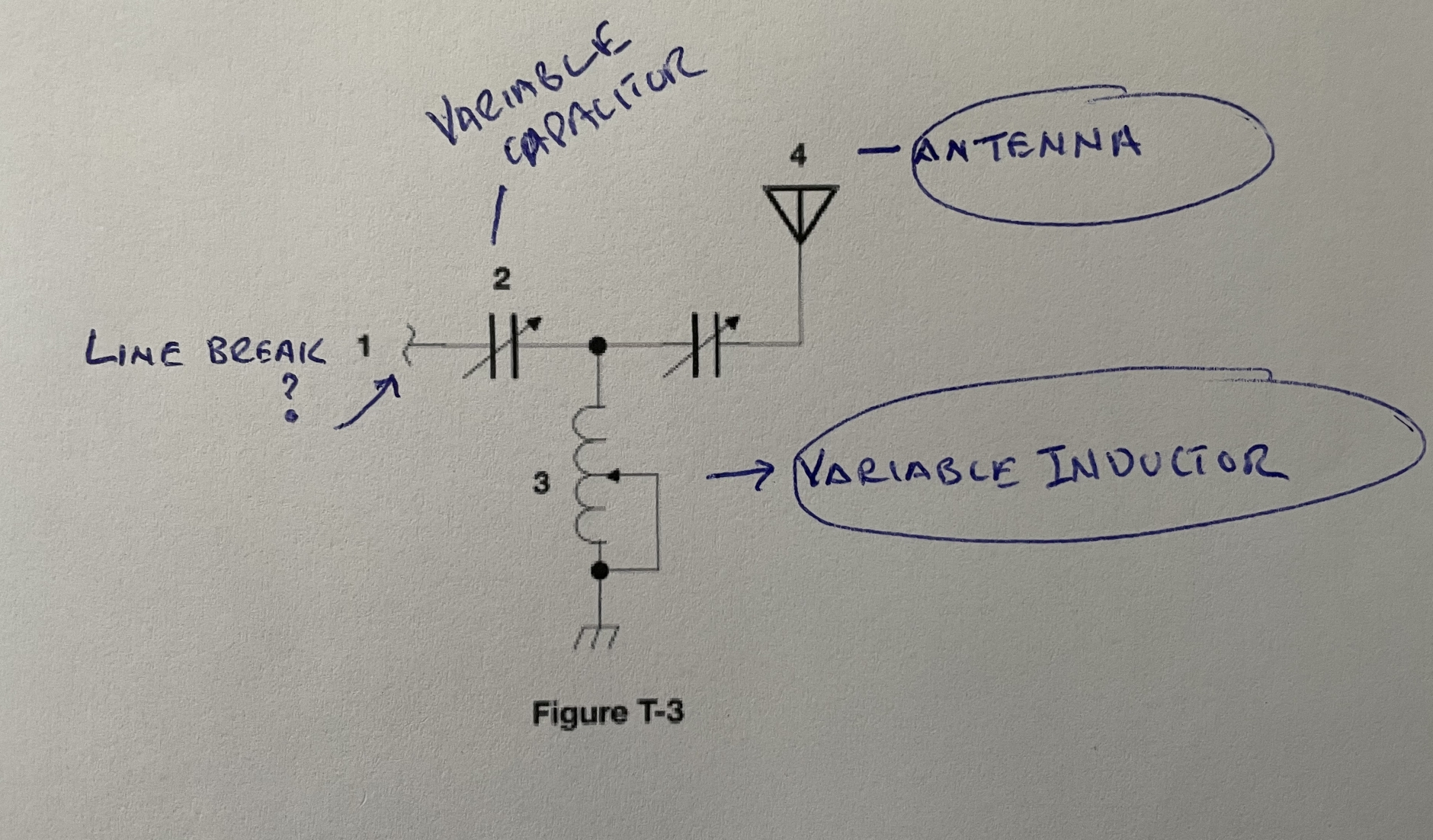
- Component 3 is a variable inductor. [The symbol looks like a coil. Imagine the arrow sliding up and down to change the value]
- Component 4 is an antenna. [It looks like a funnel to collect radio waves]
- A tuned circuit is composed of an inductor and capacitor. T-3 is a tuned circuit.
- A resonant or tuned circuit is an inductor and capacitor connected in series or parallel that form a filter.
- The component that displays an electrical quantity as a numeric value is a meter.
- A relay is an electrically controlled switch.
- The type of circuit that controls the voltage from a power supply is called the regulator.
- The device that combines several semiconductors and other components into one package is an integrated circuit.
Decibels
- Decibels are logarithmic (power of 10) and relative to relative change.
- Going from 20 to 200 watts is 10 times or 10 dBs.
- Going from 5 watts to 10 watts is 3 dB.[Doubling is 3 dB. It doesn't matter where you start, if you double, it is 3 dB]
- A power decrease from 12 watts to 3 watts is -6 dB.
- An example of using decibels is to compare results:
- a good 2 meter directional antenna might have a gain of 9 dB (so 8 times the power). To get the same result for your 50 watt desktop radio, you'd have to buy a 400 watt amplifier. The antenna is much cheaper.
- Decibels can also be used to compare different types of coax.
- Guidance
- When power is doubling/halving, add/subtract 3 dB
- When power increases by a factor of 10, add 10 dB
Moving Decimals
- A kilovolt would be one-thousand volts.
Kilo = 1,000 ... Mega = 1,000,000 ... Giga = 1,000,000,000
- Another way to specify a frequency of 1,500,000 hertz is 1500 kHz.
- 2425 MHz would be the same thing as 2.425 GHz.
- 28,400 kHz would be the same as 28.400 MHz.
- A frequency display of 3.525 MHz is the same as 3,525 MHz. [When going to a smaller identifier (Mhz to kHz) change the period to a comma]
- One microvolt is one, one-millionth of a volt.
milli = 1/1000 ... micro = 1/1,000,000 ... pico = 1/1,000,000,000,000
- A 3000 milliampere current would be = 3 amperes [3000/1000 ... put a comma in 3000 and change it to a period]
- 500 milliwatts would be 0.5 watts.
- 1.5 amperes would be 1500 milliamperes. 1.5 * 1000
- 1,000,000 picofarads = 1 microfarad
Building Equipment and Measuring Values
- Radio and electronic soldering use rosin-core solder.
- A cold solder joint is grainy and dull.
- Multimeters measure voltage and resistance.
- Voltage is a electromotive force. We could measure it with a voltmeter hooked up in parallel with (across) the circuit.
- We measure amperes (amps) with an ammeter. An ammeter is connected in series (in line) with the circuit.
- If you're measuring resistance, be sure the circuit is not powered. You'll damage the meter if you try to measure voltage when using the resistance setting.
Antennas - Polarization
- Radiation from a half-wave dipole antenna is strongest broadside to the antenna.
- The orientation of the electric field describes a radio wave's polarization.
- A simple dipole oriented parallel to the earth's surface is horizontally polarized.
- The antenna polarization used for long distance CW and SSB on the VHF and UHF is usually horizontal. [You are reaching out beyond the horizon]
- If the antennas on opposite ends of a VHF or UHF lie are not kept in the same polarization, signals could be significantly weaker.
- Skip signals are elliptically polarized, and you can use either a vertical or horizontally polarized antenna.
- Irregular fading can be caused by the random combining of signals arriving from different paths.
- If data signals arrive via multiple paths, error rates are likely to increase.
Antennas - Lengths
- How long is a 6 meter half-wavelength dipole? 112 inches is the closest answer [6/2 = 3 meters, which is a little over 9 feet, so 9*12 is about 112]
- A quarter-wave for 145 MHz is 19 inches. [146 MHz is the 2 meter band 2/4 is .5 meter, a meter is about 36 inches, so 19 inches]
- To make an antenna resonant at a higher frequency, you would shorten it.
- The advantage of a 5/8 wavelength antenna is that it has a lower angle of radiation and more gain than a 1/4 wave.
- A type of loading can be inserting an inductor to make an antenna electrically longer. {This is not a problem with VHF/UHF because antenna sizes are manageable}
Antennas - Directional
- Yagis, Quads and Dishes are all directional antennas.
- A beam antenna concentrates signals in one direction.
- The gain of an antenna is the increase in signal strength in a specific direction compared to a reference antenna. [just remember gain increases strength for both antennas and amplifiers]
- To locate the source of noise interference or jamming use radio direction finding.
- A directional antenna is also useful for a hidden transmitter hunt. {this sport is called fox-hunting}
- When using a directional antenna, you might be able to access a distant repeater if buildings or obstructions are blocking the direct line of sight path by finding a path that reflects signals to the repeater.
Antennas - Coaxial Cables
- Coax is favored over other feed line because coax is easy to use and requires few special installation considerations.
- The characteristic impedance most often used for coax is 50 Ohms.
- When increasing frequency, coaxial cable loss increases.
- The electrical difference between RG-58 and RG-8 coaxial cable is the RG-8 has less loss.
- The lowest loss at VHF and UHF would be air-insulated hard line. The disadvantage of air core coaxial cable is that it requires special techniques to avoid water absorption.
- The most common cause for the failure of coaxial cable is moisture contamination. {the braided shield acts like a wick}
- A PL-259 connector is commonly used on HF frequencies.
- Frequencies above 400 MHz use a Type N connector.
- Seal the connectors to prevent an increase in feed line loss.
- Coax outer jacket should be resistant to ultraviolet light because ultraviolet light from the sun can damage the jacket and allow water to enter.
Antennas - Analyzers and SWR
- Use an antenna analyzer to determine if the antenna is resonant.
- You can also measure proper match with a directional wallmeter.
- The standing wave radio (SWR) is a measure of how well the load is matched.
- You want a low SWR in coaxial line to reduce signal loss.
- Power lost in the feed line is converted to heat.
- The proper location for an SWR meter is in series with the feed line between the transmitter and the antenna.
- A perfect impedance match is an SWR of 1 to 1. {Mostly this is not achievable}
- Most radios will automatically reduce power as SWR increases to protect the output amplifier transistors.
- An SWR of 4:1 would indicate an impedance mismatch.
- You can use an antenna tuner (antenna coupler) to help match the antenna system impedance to the transceiver. {it's best to fix at the antenna}
- If you have erratic changes in SWR readings, you might have a loose connection in the antenna or feed line.
- A dummy load prevents transmission of signals over the air when making tests.
- A dummy load consists of a non-inductive resistor and heat sink.
Batteries
- Rechargeable batteries include:
- Nickel-metal hydrude
- Lithium-ion
- Lead-acid gel cell
- Carbon Zinc are non-rechargeable batteries.
- A mobile transceiver requires about 12 volts.
- Connect the negative side of the power cable to the battery or engine block ground strap. {negative/ground is the black wire.}
Other Notes:
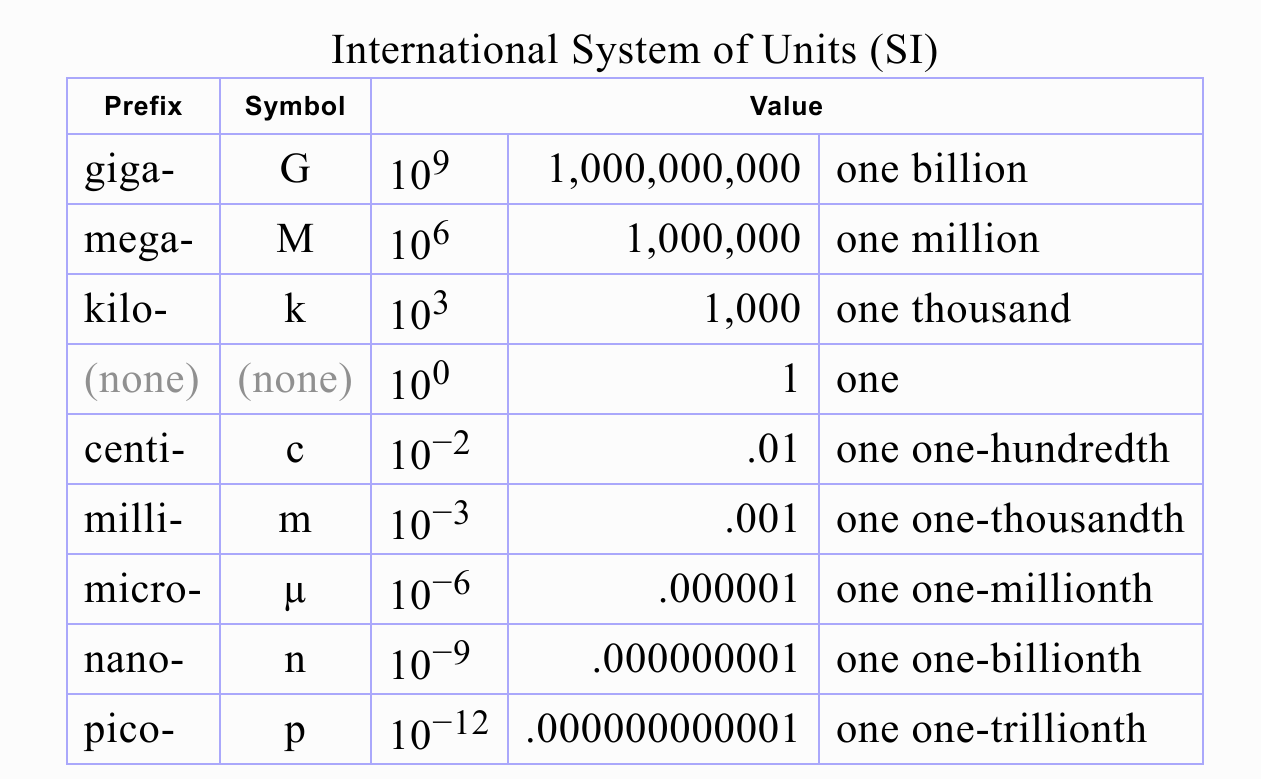
Typical Bandwidths for Signal Types
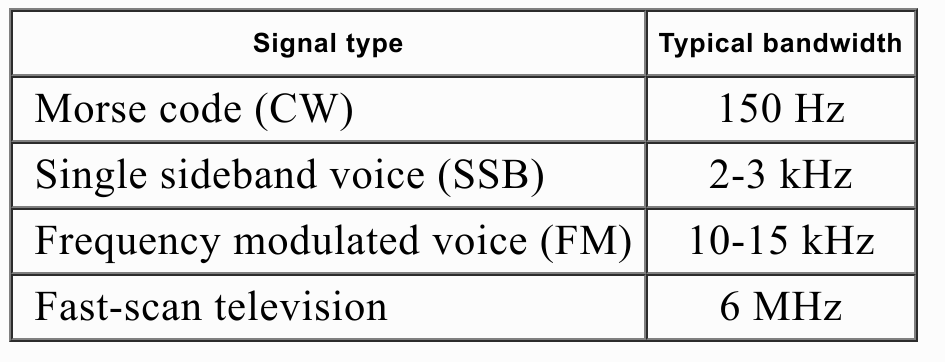
Repeater Offsets
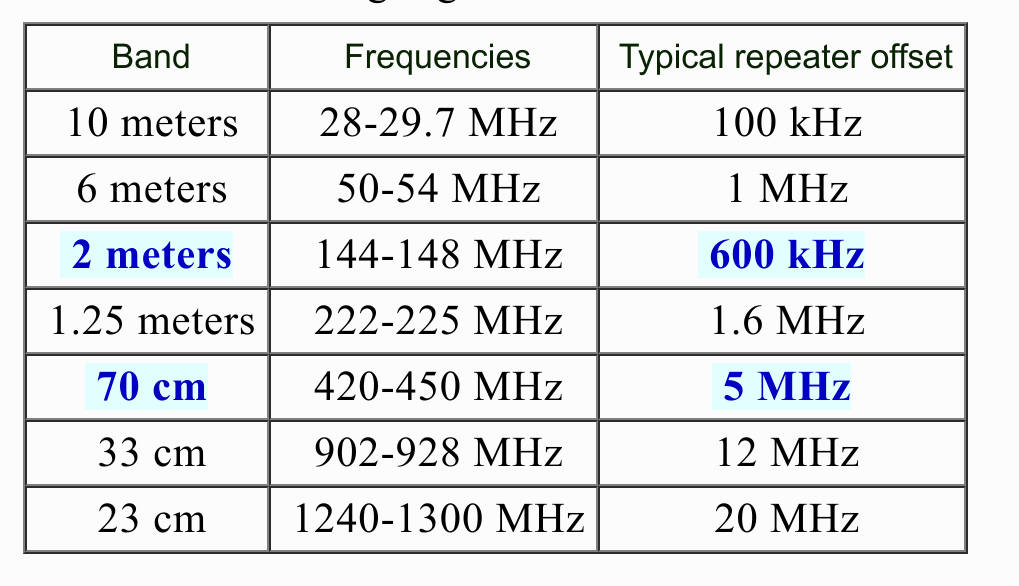
Technician Class Frequency Privileges
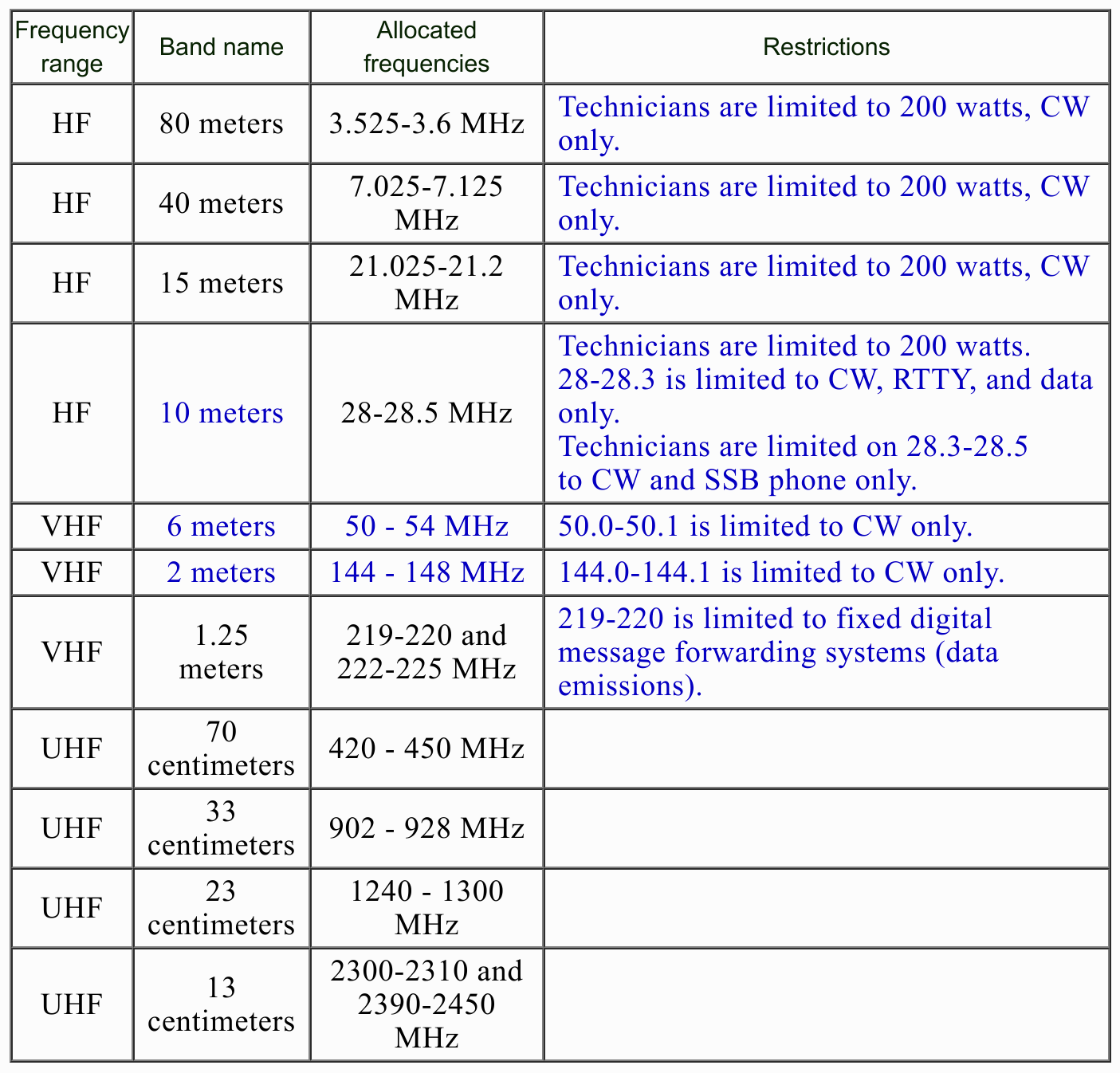

Comments2
Passed my Technician License Exam!
I was able to take my technician amateur radio license virtually via AA7HW. I learned about AA7HW via HAMTestOnline. Because I'm ridiculous, I waited to take the test after I got 100% for all 400+ questions, which took about a week. I got all the question correct! I can't wait to receive my call sign. I think I might start pursuing General (maybe Extra) within the year.
KC1OXG
Just got my call sign! KC1OXG